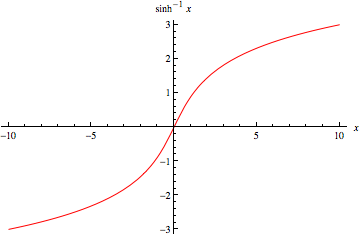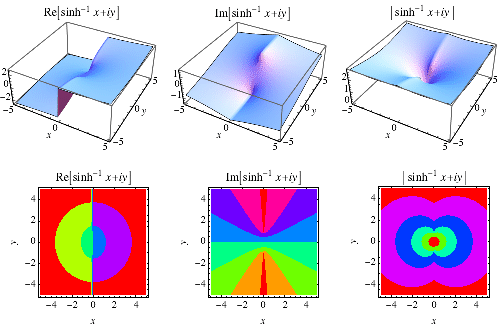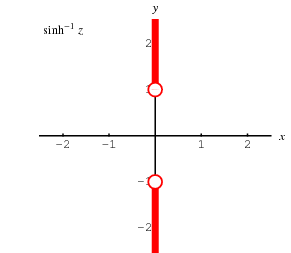


 تاريخ الرياضيات
تاريخ الرياضيات
 الرياضيات في الحضارات المختلفة
الرياضيات في الحضارات المختلفة 
 الرياضيات المتقطعة
الرياضيات المتقطعة
 الجبر
الجبر
 الهندسة
الهندسة 
 المعادلات التفاضلية و التكاملية
المعادلات التفاضلية و التكاملية 
 التحليل
التحليل
 علماء الرياضيات
علماء الرياضيات |
Read More
Date: 28-4-2019
Date: 15-10-2019
Date: 19-5-2019
|
 |
 |
The inverse hyperbolic sine  (Beyer 1987, p. 181; Zwillinger 1995, p. 481), sometimes called the area hyperbolic sine (Harris and Stocker 1998, p. 264) is the multivalued function that is the inverse function of the hyperbolic sine.
(Beyer 1987, p. 181; Zwillinger 1995, p. 481), sometimes called the area hyperbolic sine (Harris and Stocker 1998, p. 264) is the multivalued function that is the inverse function of the hyperbolic sine.
The variants  or
or  (Harris and Stocker 1998, p. 263) are sometimes used to refer to explicit principal values of the inverse hyperbolic sine, although this distinction is not always made. Worse yet, the notation
(Harris and Stocker 1998, p. 263) are sometimes used to refer to explicit principal values of the inverse hyperbolic sine, although this distinction is not always made. Worse yet, the notation  is sometimes used for the principal value, with
is sometimes used for the principal value, with  being used for the multivalued function (Abramowitz and Stegun 1972, p. 87). The notations
being used for the multivalued function (Abramowitz and Stegun 1972, p. 87). The notations  (Jeffrey 2000, p. 124) and
(Jeffrey 2000, p. 124) and  (Gradshteyn and Ryzhik 2000, p. xxx) are sometimes also used. Note that in the notation
(Gradshteyn and Ryzhik 2000, p. xxx) are sometimes also used. Note that in the notation  ,
,  is the hyperbolic sine and the superscript
is the hyperbolic sine and the superscript  denotes an inverse function, not the multiplicative inverse.
denotes an inverse function, not the multiplicative inverse.
Its principal value of  is implemented in the Wolfram Language as ArcSinh[z] and in the GNU C library as asinh(double x).
is implemented in the Wolfram Language as ArcSinh[z] and in the GNU C library as asinh(double x).

The inverse hyperbolic sine is a multivalued function and hence requires a branch cut in the complex plane, which the Wolfram Language's convention places at the line segments  and
and  . This follows from the definition of
. This follows from the definition of  as
as
 |
(1) |
The inverse hyperbolic sine is given in terms of the inverse sine by
 |
(2) |
(Gradshteyn and Ryzhik 2000, p. xxx).
The derivative of the inverse hyperbolic sine is
 |
(3) |
and the indefinite integral is
 |
(4) |
It has a Maclaurin series
 |
 |
 |
(5) |
 |
 |
 |
(6) |
 |
 |
 |
(7) |
(OEIS A055786 and A002595), where  is a Legendre polynomial. It has a Taylor series about infinity of
is a Legendre polynomial. It has a Taylor series about infinity of
 |
 |
 |
(8) |
 |
 |
 |
(9) |
REFERENCES:
Abramowitz, M. and Stegun, I. A. (Eds.). "Inverse Circular Functions." §4.4 in Handbook of Mathematical Functions with Formulas, Graphs, and Mathematical Tables, 9th printing. New York: Dover, pp. 79-83, 1972.
Beyer, W. H. CRC Standard Mathematical Tables, 28th ed. Boca Raton, FL: CRC Press, pp. 142-143, 1987.
GNU C Library. "Mathematics: Inverse Trigonometric Functions." http://www.gnu.org/manual/glibc-2.2.3/html_chapter/libc_19.html#SEC391.
Gradshteyn, I. S. and Ryzhik, I. M. Tables of Integrals, Series, and Products, 6th ed. San Diego, CA: Academic Press, p. xxx, 2000.
Harris, J. W. and Stocker, H. Handbook of Mathematics and Computational Science. New York: Springer-Verlag, 1998.
Jeffrey, A. "Inverse Trigonometric and Hyperbolic Functions." §2.7 in Handbook of Mathematical Formulas and Integrals, 2nd ed.Orlando, FL: Academic Press, pp. 124-128, 2000.
Sloane, N. J. A. Sequences A002595/M4233, A052468, A052469, and A055786 in "The On-Line Encyclopedia of Integer Sequences."
Spanier, J. and Oldham, K. B. "Inverse Trigonometric Functions." Ch. 35 in An Atlas of Functions. Washington, DC: Hemisphere, pp. 331-341, 1987.
Zwillinger, D. (Ed.). "Inverse Hyperbolic Functions." §6.8 in CRC Standard Mathematical Tables and Formulae. Boca Raton, FL: CRC Press, pp. 481-483, 1995.



|
|
|
|
دراسة يابانية لتقليل مخاطر أمراض المواليد منخفضي الوزن
|
|
|
|
|
|
|
اكتشاف أكبر مرجان في العالم قبالة سواحل جزر سليمان
|
|
|
|
|
|
|
المجمع العلمي ينظّم ندوة حوارية حول مفهوم العولمة الرقمية في بابل
|
|
|